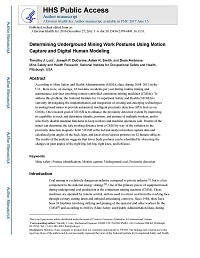Mining Publication: Determining Underground Mining Work Postures Using Motion Capture and Digital Human Modeling
Original creation date: December 2016
Authors: TJ Lutz, JP Ducarme, A Smith, D Ambrose
According to Mine Safety and Health Administration (MSHA) data, between 2008 and 2012 in the U.S., there were, on average, 65 lost-time accidents per year during routine mining and maintenance activities involving remote-controlled continuous mining machines (CMMs). To address this problem, the National Institute for Occupational Safety and Health (NIOSH) is currently investigating the implementation and integration of existing and emerging technologies in underground mines to provide automated, intelligent proximity detection (iPD) devices on CMMs. One research goal of NIOSH is to enhance the proximity detection system by improving its capability to track and determine identity, position, and posture of multiple workers, and to selectively disable machine functions to keep workers and machine operators safe. Posture of the miner can determine the safe working distance from a CMM by way of the variation in the proximity detection magnetic field. NIOSH collected and analyzed motion capture data and calculated joint angles of the back, hips, and knees from various postures on 12 human subjects. The results of the analysis suggests that lower body postures can be identified by observing the changes in joint angles of the right hip, left hip, right knee, and left knee.

- An Active Proximity Warning System for Surface and Underground Mining Applications
- An Environmentally Robust Proximity Warning System for Hazardous Areas
- Evaluation of an advanced proximity detection system for continuous mining machines
- Innovative Safety Interventions: Feasibility of Using Intelligent Video for Machinery Applications
- Intelligent Proximity Detection to Improve Miner Safety
- Proximity Detection
- Proximity Detection: A Continuing Research Imperative
- Recommendations for Evaluating & Implementing Proximity Warning Systems on Surface Mining Equipment
- Test Results of Collision Warning Systems for Surface Mining Dump Trucks
- Test Results of Collision Warning Systems on Off-Highway Dump Trucks: Phase 2